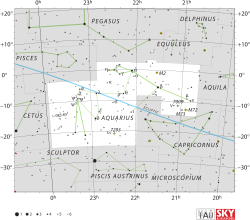Star in the constellation Aquarius
98 Aquarii (abbreviated 98 Aqr ) is a star in the equatorial constellation of Aquarius . 98 Aquarii is the Flamsteed designation , although it also bears the Bayer designation b1 Aquarii . It is visible to the naked eye with an apparent visual magnitude of +3.97.[ 2] light-years (50 parsecs ), is known from parallax measurements made with the Hipparcos spacecraft.[ 1]
With over double the mass of the Sun,[ 5] evolved giant star that has a stellar classification of K0 III.[ 3] angular diameter of this star is 2.54 ± 0.13 mas .[ 8] [ 1] radius of the Sun .[ 6] effective temperature of 4,630 K,[ 5] K-type star .[ 9]
References
^ a b c d e f g van Leeuwen, F. (November 2007), "Validation of the new Hipparcos reduction", Astronomy and Astrophysics , 474 (2): 653– 664, arXiv :0708.1752 Bibcode :2007A&A...474..653V , doi :10.1051/0004-6361:20078357 , S2CID 18759600 ^ a b c d Jennens, P. A.; Helfer, H. L. (September 1975), "A new photometric metal abundance and luminosity calibration for field G and K giants.", Monthly Notices of the Royal Astronomical Society 172 (3): 667– 679, Bibcode :1975MNRAS.172..667J , doi :10.1093/mnras/172.3.667 ^ a b Houk, Nancy (1978), Michigan catalogue of two-dimensional spectral types for the HD stars , vol. 4, Ann Arbor: Dept. of Astronomy, University of Michigan, Bibcode :1988mcts.book.....H ^ Wielen, R.; et al. (1999), "Sixth Catalogue of Fundamental Stars (FK6). Part I. Basic fundamental stars with direct solutions", Veroeffentlichungen des Astronomischen Rechen-Instituts Heidelberg , 35 (35), Astronomisches Rechen-Institut Heidelberg: 1, Bibcode :1999VeARI..35....1W ^ a b c d e f Melo, C. H. F.; et al. (August 2005), "On the nature of lithium-rich giant stars. Constraints from beryllium abundances", Astronomy and Astrophysics , 439 (1): 227– 235, arXiv :astro-ph/0504133 Bibcode :2005A&A...439..227M , doi :10.1051/0004-6361:20041805 , S2CID 10580797 ^ a b Lang, Kenneth R. (2006), Astrophysical formulae Birkhäuser , ISBN 3-540-29692-1 * ) is given by:
2
⋅
R
∗
=
(
50.1
⋅
2.54
⋅
10
−
3
)
AU
0.0046491
AU
/
R
⨀
≈
27.4
⋅
R
⨀
{\displaystyle {\begin{aligned}2\cdot R_{*}&={\frac {(50.1\cdot 2.54\cdot 10^{-3})\ {\text{AU}}}{0.0046491\ {\text{AU}}/R_{\bigodot }}}\\&\approx 27.4\cdot R_{\bigodot }\end{aligned}}}
^ "* 98 Aqr" . SIMBAD Centre de données astronomiques de Strasbourg . Retrieved 2006-11-05 .^ Richichi, A.; Percheron, I.; Khristoforova, M. (February 2005), "CHARM2: An updated Catalog of High Angular Resolution Measurements", Astronomy and Astrophysics , 431 (2): 773– 777, Bibcode :2005A&A...431..773R , doi :10.1051/0004-6361:20042039 ^ "The Colour of Stars" , Australia Telescope, Outreach and Education , Commonwealth Scientific and Industrial Research Organisation , December 21, 2004, archived from the original on February 22, 2012, retrieved 2012-01-16

